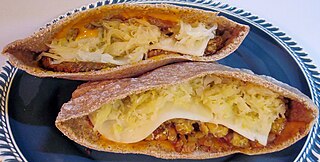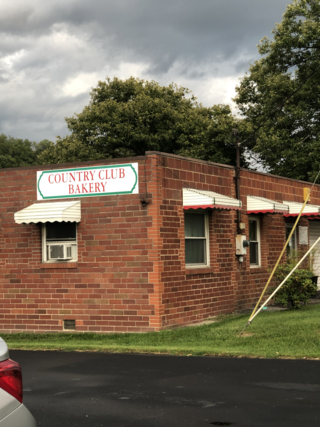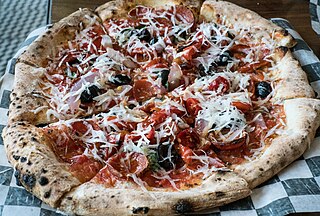
Midwestern cuisine is a regional cuisine of the American Midwest. It draws its culinary roots most significantly from the cuisines of Central, Northern and Eastern Europe, and Indigenous cuisine of the Americas, and is influenced by regionally and locally grown foodstuffs and cultural diversity.

New England cuisine is an American cuisine which originated in the New England region of the United States, and traces its roots to traditional English cuisine and Native American cuisine of the Abenaki, Narragansett, Niantic, Wabanaki, Wampanoag, and other native peoples. It also includes influences from Irish, French, Italian, and Portuguese cuisine, among others. It is characterized by extensive use of potatoes, beans, dairy products and seafood, resulting from its historical reliance on its seaports and fishing industry. Corn, the major crop historically grown by Native American tribes in New England, continues to be grown in all New England states, primarily as sweet corn although flint corn is grown as well. It is traditionally used in hasty puddings, cornbreads and corn chowders.

Pepperoni is a variety of spicy salami made from cured pork and beef seasoned with paprika or other chili pepper.

A roll is a small, usually round or oblong individual loaf of bread served as a meal accompaniment. Rolls can be served and eaten whole or are also commonly cut and filled – the result of doing so is considered a sandwich in American English.

A calzone is an Italian oven-baked turnover, made with leavened dough. It originated in Naples in the 18th century. A typical calzone is made from salted bread dough, baked in an oven and is stuffed with salami, ham or vegetables, mozzarella, ricotta and Parmesan or pecorino cheese, as well as an egg. Different regional variations in or on a calzone can often include other ingredients that are normally associated with pizza toppings. The term usually applies to an oven-baked turnover rather than a fried pastry, though calzoni and panzerotti are often mistaken for each other.

Totino's and Jeno's are brands of frozen pizza products owned by General Mills.
Hot Pockets is an American brand of microwaveable turnovers generally containing one or more types of cheese, meat, or vegetables. Hot Pockets was founded by Chef America Inc. Since April 20, 2002, they have been produced by Nestlé.

Stromboli is a type of baked turnover filled with various Italian cheeses and usually Italian cold cuts or vegetables served hot. The dough used is either Italian bread dough or pizza dough. Stromboli was invented by Italian-Americans in the United States in the Philadelphia area. The name of the dish is taken from a volcanic island off the coast of Sicily.

Sausage bread is an American food made of sausage and other ingredients rolled or enclosed in dough and cooked in an oven.

Tip Top Bakeries is an Australian manufacturer of bread products owned by George Weston Foods, a subsidiary of multinational food giant Associated British Foods.

Pepperidge Farm is an American commercial bakery founded in 1937 by Margaret Rudkin, who named the brand after her family's 123-acre farm property in Fairfield, Connecticut, which had been named for the pepperidge tree.

Pocket sandwich is a sandwich which is made using a single piece of folded or hollowed bread, such as a pita, which is made from dough cooked with fillings inside.

The First Strike Ration (FSR) is a compact assault United States military ration. It is designed to be consumed on the move during the first 72 hours of conflict. It was created by the United States Army Soldier Systems Center in Natick, Massachusetts. The U.S. Army said the FSR substantially reduces weight and load and is intended to enhance a consumer's physical performance, mental acuity, and mobility.

Country Club Bakery is a bakery located in Fairmont, West Virginia, which is where the pepperoni roll originated. The bakery is currently located on Country Club Road. The pepperoni roll is a snack popular in West Virginia and some nearby regions of the Appalachian Mountains.

Roman Candle Baking Co., or simply Roman Candle, was a bakery and pizzeria–restaurant in the Richmond neighborhood of Portland, Oregon. Duane Sorenson opened Roman Candle in 2013, with a menu offering wood-fired pizza and other Italian cuisine, including sandwiches, breads, green salads, pastries, and baked potatoes. Dan Griffin and Joshua McFadden served as the baker and chef, respectively. The bakery started supplying select menu items to Sorenson's Stumptown Coffee Roasters locations in late 2015. Roman Candle received a generally positive reception, with the pizzas and kouign-amann receiving the most praise. The restaurant closed in April 2018 for renovations, ahead of a rebrand as a gluten-free and vegan cafe called Holiday, which Sorenson launched one month later.

An Xuyên Bakery is a bakery in Portland, Oregon.

Bella's Italian Bakery is a bakery in Portland, Oregon.

Ohio Valley-style pizza is a pizza made with cold toppings sprinkled over a square crust that has been covered with a sweet tomato sauce. It originated in Steubenville, Ohio and is commonly served in Ohio and West Virginia.


















